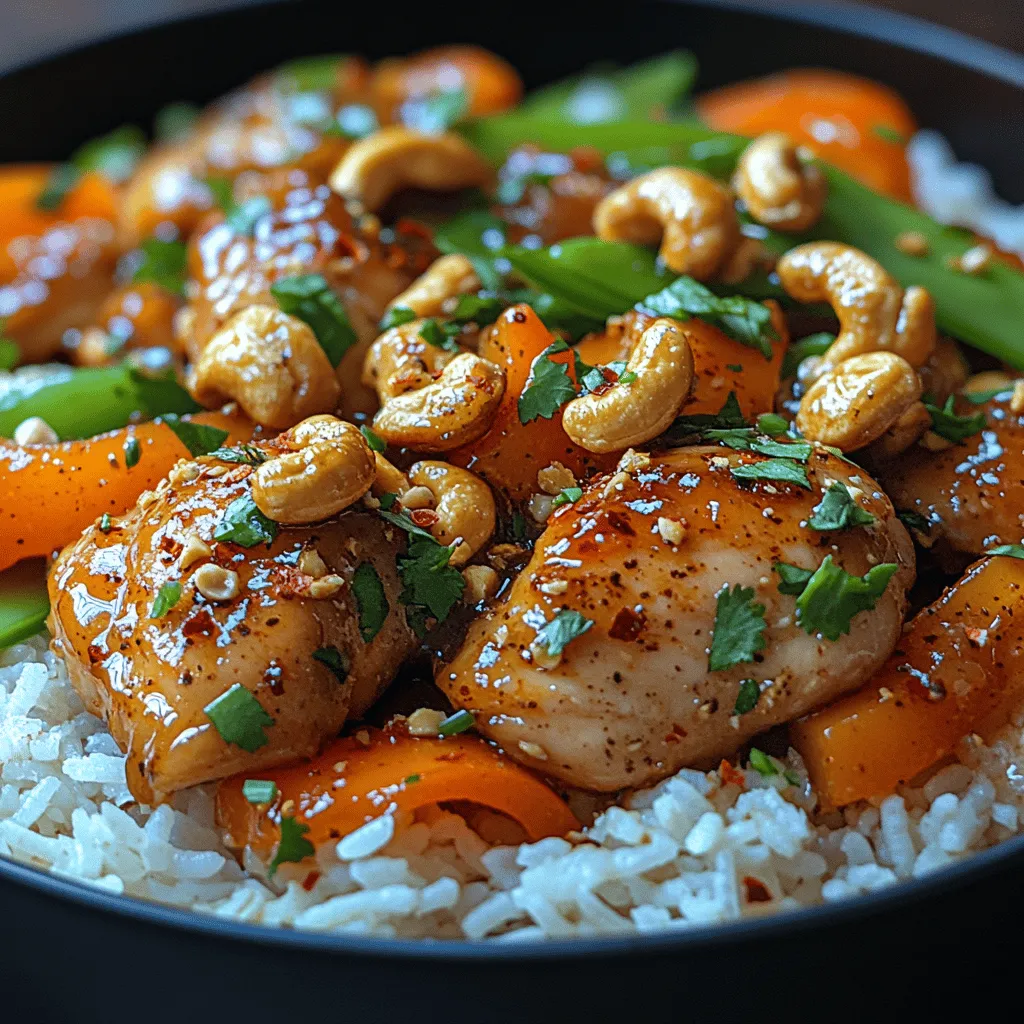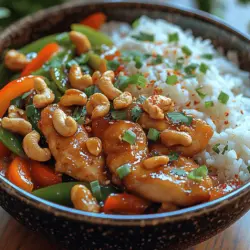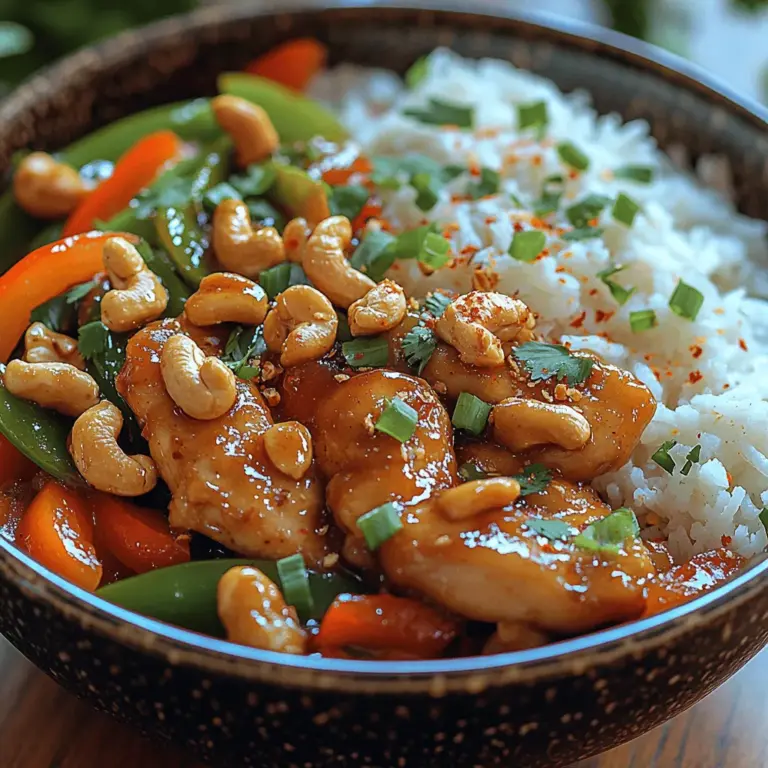Thai Cashew Chicken Stir Fry is a delightful blend of flavors and textures that embodies the essence of Thai cuisine. This dish combines tender chicken thighs, crunchy cashews, and vibrant vegetables, all enveloped in a savory sauce that tantalizes the taste buds. It’s a perfect representation of how Thai cooking harmonizes a variety of ingredients to create dishes that are not only delicious but also visually appealing. In this article, we will explore the step-by-step process to create this delicious stir fry, delve into its nutritional benefits, and discuss its cultural significance. Whether you’re a seasoned cook or a culinary novice, this recipe is sure to impress and satisfy.
Understanding Thai Cuisine
The Richness of Thai Flavors
Thai cuisine is celebrated for its unique combination of flavors that create a symphony of taste in every dish. At the heart of Thai cooking lies the balance of four fundamental tastes: sweet, salty, sour, and spicy. This balance is achieved through the use of a variety of ingredients that are staples in Thai kitchens.
Common ingredients include:
– Herbs and Spices: Fresh herbs like basil, cilantro, and lemongrass are often used, along with spices such as chili, garlic, and ginger.
– Fruits and Vegetables: Thai dishes are rich in fresh produce, providing not only flavor but also color and texture.
– Sauces: Essential sauces like soy sauce, oyster sauce, and fish sauce add depth and complexity to dishes, enhancing their overall flavor profile.
The interplay of these ingredients results in dishes that are bold and exciting, making Thai cuisine a favorite among food lovers worldwide.
Cultural Significance of Stir Fry Dishes
Stir-frying is a cooking technique that has deep historical roots in Thai culture. This method of cooking allows for quick preparation while preserving the nutrients and flavors of the ingredients. Traditionally, stir-frying is done over high heat, which seals in the juices of proteins and keeps vegetables crisp, creating a dish that is both wholesome and satisfying.
In modern Thai meals, stir fry dishes like Thai Cashew Chicken are ubiquitous, found in homes and restaurants alike. They are not only quick to prepare but also adaptable, making them a go-to option for busy weeknights or festive gatherings. The popularity of stir fry in Thai cuisine speaks to its versatility and the skillful balance of flavors that defines this culinary tradition.
Ingredients Breakdown
Essential Ingredients for Thai Cashew Chicken Stir Fry
To create a delicious Thai Cashew Chicken Stir Fry, the right ingredients are key. Here’s a breakdown of what you’ll need:
– Chicken Thighs: While chicken breasts are often seen as a healthier option, chicken thighs are preferred in this recipe for their richer flavor and juicier texture. The higher fat content in thighs allows them to stay moist during cooking, which is especially important in a quick stir-fry where overcooking can lead to dryness.
– Cashews: Cashews are not just a crunchy addition; they also bring a unique flavor profile to the dish. Nutritionally, cashews are packed with healthy fats, protein, and essential vitamins and minerals. They add a satisfying crunch and a buttery taste that complements the savory chicken and vegetables beautifully.
– Vegetables: Fresh produce is at the heart of Thai dishes. For this stir fry, a mix of bell peppers, broccoli, and snap peas can be used, providing a vibrant mix of colors and textures. The freshness of the vegetables adds a crisp contrast to the tender chicken and rich sauce.
– Sauces: The flavor of the stir fry is largely attributed to the sauces used. Soy sauce contributes a salty umami flavor, while oyster sauce adds sweetness and depth. Fish sauce, a staple in Thai cooking, offers a distinct taste that enhances the overall profile of the dish.
Substitutions and Variations
One of the joys of cooking is the ability to adapt recipes to suit personal tastes or dietary preferences. Here are some suggestions for substitutions and variations:
– Alternative Proteins: For those who prefer a vegetarian or pescatarian option, tofu or shrimp can be substituted for chicken. Tofu can absorb flavors well and provides a satisfying texture, while shrimp cooks quickly and adds a seafood twist.
– Vegetable Variations: Feel free to experiment with seasonal vegetables based on availability. Zucchini, carrots, and green beans are excellent additions that can provide different flavors and textures.
– Adjusting Spice Levels: If you enjoy a milder flavor, reduce the amount of chili or use a less spicy variety. Conversely, for those who crave heat, consider adding fresh chili slices or a dash of chili paste to elevate the spice level.
Step-by-Step Recipe Guide
To make your Thai Cashew Chicken Stir Fry, preparation is key. The following steps will guide you through the process, ensuring a seamless cooking experience.
Preparing the Ingredients
Before you begin cooking, it’s essential to have everything ready. This concept, known as mise en place, involves organizing and preparing all your ingredients ahead of time. This not only saves time during cooking but also helps prevent any last-minute scrambling for ingredients.
– Cutting the Chicken: Start by trimming any excess fat from the chicken thighs and cutting them into bite-sized pieces. This ensures even cooking and allows the flavors to penetrate the meat.
– Chopping Vegetables: Wash and chop your choice of vegetables into uniform pieces. This will help them cook evenly in the stir fry. For instance, slice bell peppers into strips, and cut broccoli into small florets.
– Measuring Sauces: Measure out the soy sauce, oyster sauce, and fish sauce in small bowls. Having these ready will make the cooking process smoother and more efficient.
Toasting the Cashews
Toasting the cashews before adding them to the stir fry is a crucial step that enhances their flavor and texture.
– Techniques for Achieving the Perfect Toast: Heat a dry skillet over medium heat. Add the cashews and stir frequently to prevent burning. Toast them until they are golden brown and fragrant, which usually takes about 3-5 minutes. Keep a close eye on them, as they can go from perfectly toasted to burnt quickly.
– Why Toasting Enhances Flavor and Texture: Toasting cashews releases their natural oils and intensifies their flavor. The result is a nuttier taste and a satisfying crunch that elevates your stir fry, making each bite more enjoyable.
Cooking the Chicken
Once your ingredients are prepped and your cashews are toasted, it’s time to cook the chicken.
– Best Practices for Browning Chicken Evenly: Heat a tablespoon of oil in a large skillet or wok over medium-high heat. Once the oil is hot, add the chicken in a single layer, ensuring not to overcrowd the pan. This allows the chicken to brown evenly and develop a nice sear.
– Cooking Time: Stir-fry the chicken for about 5-7 minutes, or until it is cooked through and no longer pink in the center. If you’re using a meat thermometer, the internal temperature should reach 165°F (75°C).
By following these steps, you’ll be well on your way to creating a mouthwatering Thai Cashew Chicken Stir Fry that captures the vibrant spirit of Thai cuisine. Stay tuned for the next part of the article, where we will delve into combining all the ingredients and perfecting the sauce to complete this delicious dish.

Tips for Achieving a Juicy and Tender Result
Making the perfect Thai Cashew Chicken Stir Fry begins with ensuring your chicken remains juicy and tender. Here are some expert tips to achieve that mouthwatering texture:
1. Choose the Right Chicken: Opt for boneless, skinless chicken thighs instead of breasts. Thighs have a higher fat content, making them juicier and more forgiving during cooking.
2. Marinate the Chicken: A simple marinade of soy sauce, cornstarch, and a touch of sesame oil for about 15-30 minutes prior to cooking will infuse flavor and help retain moisture during the stir-fry process.
3. Cook in Batches: If you’re making a large quantity, avoid overcrowding the pan. Cooking in batches allows the chicken to sear properly, locking in juices and preventing steaming.
4. Monitor Cooking Time: Chicken cooks quickly in a hot wok. Aim for an internal temperature of 165°F (75°C) and remove it from the heat immediately to prevent overcooking.
Sautéing the Vegetables
Vegetables in a stir fry should be vibrant, crisp, and full of flavor. Here’s how to achieve that:
1. Timing for Adding Garlic and Ginger: Start by heating your oil until shimmering. Add the ginger and garlic after the vegetables have been sautéed for a minute or two. This allows the vegetables to soften slightly and ensures that the garlic and ginger don’t burn, which can create a bitter taste.
2. Stir-Fry Without Overcooking: Keep your vegetables moving! A high heat and constant stirring will help them cook evenly while maintaining their crunch. Aim for about 2-3 minutes for bell peppers, broccoli, and snap peas—just enough time for them to become tender but still crisp.
Combining Ingredients
When it comes to mixing your sauces and ingredients, the following tips can ensure a well-balanced flavor profile:
1. Mixing Sauces: Combine your sauces (like soy sauce, oyster sauce, and fish sauce) in a small bowl before adding them to the stir fry. This allows for even distribution and prevents clumping.
2. Layering Flavors: Start with aromatics, then add proteins, followed by vegetables. Layering not only builds depth in flavor but also enhances the overall dish. Always taste your stir fry before serving to adjust seasoning as necessary.
Thickening the Sauce
A well-thickened sauce can elevate your stir fry. Understanding cornstarch’s role is crucial:
1. Role of Cornstarch: Cornstarch acts as a thickening agent when mixed with liquid. When you add it to your sauce mixture, it creates a velvety texture that clings to the chicken and vegetables.
2. Avoiding Clumps: To prevent clumps, dissolve cornstarch in a small amount of cold water before adding it to your heated sauce. This will ensure a smooth consistency as it thickens.
Finishing Touches
Finishing touches can make your dish pop with flavor and visual appeal:
1. Importance of Lime Juice: A squeeze of fresh lime juice just before serving brightens the dish, adding a refreshing zing that balances the richness of the sauce.
2. Garnishing Tips: Consider garnishing your stir fry with chopped green onions, crushed peanuts, or fresh cilantro. Not only do these add flavor, but they also enhance the visual appeal of your dish.
Serving Suggestions
To complement your Thai Cashew Chicken Stir Fry, consider the following serving suggestions:
Ideal Accompaniments
1. Pairing with Jasmine Rice or Noodles: Serve your stir fry over fluffy jasmine rice or alongside rice noodles. Both options absorb the sauce beautifully and provide a satisfying base for the dish.
2. Suggested Side Dishes: To create a full meal, serve with simple cucumber salad, steamed bok choy, or a light Thai soup like Tom Yum to enhance the dining experience.
Presentation Tips
1. Creative Plating Ideas: For a restaurant-style presentation, serve your stir fry in a shallow bowl with a mound of rice slightly offset to one side. Arrange the stir fry on top, and drizzle any remaining sauce over the chicken and vegetables.
2. Importance of Color and Texture: Use a variety of colorful vegetables to create a visually appealing dish. The contrasts in color and texture will not only entice the eyes but also enhance the overall eating experience.
Nutritional Information
Understanding the nutritional benefits of your meal is essential for maintaining a balanced diet.
Health Benefits of the Ingredients
1. Overview of Nutrients: This dish is packed with protein from the chicken and healthy fats from the cashews. Additionally, the vegetables provide essential vitamins and minerals, making this stir fry both nutritious and satisfying.
2. Caloric Breakdown: A typical serving of Thai Cashew Chicken Stir Fry contains approximately 400-500 calories, depending on the portion size and the amount of oil used. This makes it a balanced meal option that can fit well into most dietary plans.
Balancing the Meal
1. How This Dish Fits into a Balanced Diet: This recipe contains a good balance of protein, healthy fats, and carbohydrates, which can help keep you fuller for longer while providing energy.
2. Tips for Portion Control and Meal Prepping: When preparing this dish for meal prep, consider dividing it into portion-sized containers. This not only helps with portion control but also makes it easy to grab a healthy meal on busy days.
Conclusion
Thai Cashew Chicken Stir Fry is not just a meal; it’s an experience that brings together the vibrant flavors and health benefits of Thai cuisine. This recipe is versatile, allowing for personal touches and adjustments to suit individual tastes. By following the detailed instructions and understanding the ingredients, you can create a delicious and satisfying dish that will delight your family and friends. Embrace the art of stir-frying and enjoy the rich tapestry of flavors that this Thai classic has to offer. Whether you’re preparing a weeknight dinner or a special occasion feast, this stir fry will surely impress and satisfy.


